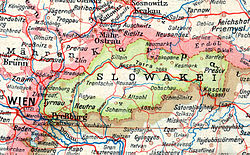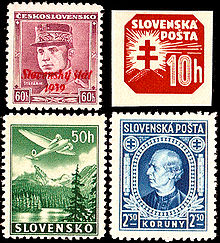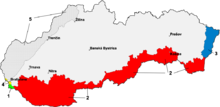Slovak Republic (1939–1945)
It has been suggested that Slovakia during World War II be merged into this article. (Discuss) Proposed since October 2011. |
This article has multiple issues. Please help improve it or discuss these issues on the talk page. (Learn how and when to remove these messages)
No issues specified. Please specify issues, or remove this template. |
Slovak Republic Slovenská republika¹ | |||||||||||
|---|---|---|---|---|---|---|---|---|---|---|---|
| 1939–1945 | |||||||||||
| Anthem: Hej Slováci | |||||||||||
 | |||||||||||
| Status | Client state of Germany | ||||||||||
| Capital | Bratislava | ||||||||||
| Common languages | Official language: Slovak Minority languages: German, Hungarian | ||||||||||
| Government | Single-party republic | ||||||||||
| President | |||||||||||
• 1939–1945 | Jozef Tiso | ||||||||||
| Prime Minister | |||||||||||
• 1939 | Jozef Tiso | ||||||||||
• 1939–1944 | Vojtech Tuka | ||||||||||
• 1944–1945 | Štefan Tiso | ||||||||||
| Historical era | World War II | ||||||||||
• Secession | 14 March 1939 | ||||||||||
| 29 August 1944 | |||||||||||
• Fall of Bratislava | 4 April 1945 | ||||||||||
| 8 May 1945 | |||||||||||
| Area | |||||||||||
| 1940 | 38,055 km2 (14,693 sq mi) | ||||||||||
| Population | |||||||||||
• 1940 | 2,653,053 | ||||||||||
| Currency | Slovak koruna | ||||||||||
| ISO 3166 code | SK | ||||||||||
| |||||||||||
¹ Slovenský štát (semi-official; until 21 July 1939) | |||||||||||


The Slovak Republic (Slovak: Slovenská republika), also known as the First Slovak Republic (Slovak: Prvá slovenská republika) or the Slovak State (Slovak: Slovenský štát), was a semi-independent state under strong influence of Nazi Germany, which existed from 14 March 1939 to 8 May 1945. It existed on roughly the same territory as present-day Slovakia (without the southern and eastern parts). The Republic bordered Germany, the Protectorate of Bohemia and Moravia, General Government (German-occupied remnant of Poland), and Hungary.
The Slovak State was recognized by Germany and several other states including China, Croatia, El Salvador, Estonia, Italy, Hungary, Japan, Lithuania, Manchukuo, Mengjiang, Romania, the Soviet Union, Spain, Switzerland, and Vatican City. The first Slovak Republic's legal existence was retroactively nullified by the World War II victorious allies through the nullification of the Munich Agreement and all its consequences.
Name
The country was called the First Slovak Republic (Slovak: prvá Slovenská republika) or Slovak State (Slovak: slovenský štát or Slovenský štát) to distinguish it from the contemporary (Second) Slovak Republic, Slovakia, which is not considered its legal successor state. The name "Slovak state" was the official name until the adoption of the Constitution on the July 21, 1939. The name "Slovak state" was used colloquially, but the official name "first Slovak republic" was used even in encyclopedias written during the communist rule.[1][2]
Creation
After the Munich Agreement, Slovakia gained autonomy inside Czecho-Slovakia (as the former Czechoslovakia had been renamed) and lost its southern territories to Hungary under the Vienna Award. As Nazi Fuhrer Adolf Hitler was preparing an invasion of the Czech lands and creation of Protectorate of Bohemia and Moravia, he had various plans for Slovakia. German officials were initially misinformed by the Hungarians that the Slovaks wanted to join Hungary. Germany decided to make Slovakia a separate state under the influence of Germany, and a potential strategic base for German attacks on Poland and other regions.
On 13 March 1939, Hitler invited Monsignor Jozef Tiso (the Slovak ex-prime minister who had been deposed by Czech troops several days earlier) to Berlin and urged him to proclaim Slovakia's independence. Hitler added that if Tiso did not consent, he would have no interest in Slovakia's fate and would leave it to the territorial claims of Hungary and of Poland. During the meeting, Joachim von Ribbentrop passed on a (false) report saying that Hungarian troops were approaching Slovak borders. Tiso refused to make such a decision himself, after which he was allowed by Hitler to organize a meeting of the Slovak parliament ("Diet of the Slovak Land"), which would approve Slovakia's independence.
On 14 March, the Slovak parliament convened and heard Tiso's report on his discussion with Hitler as well as a declaration of independence. Some of the deputies were sceptical of making such a move, but the debate was quickly quashed when Franz Karmasin, leader of the German minority in Slovakia, said that any delay in declaring independence would result in Slovakia being divided between Hungary and Germany. Under these circumstances, Parliament unanimously declared Slovak independence. Jozef Tiso was appointed the first Prime Minister of the new republic. The next day, Tiso sent a telegram (which had actually been composed the previous day in Berlin) asking the Reich to take over the protection of the newly minted state. The request was readily accepted.[3]
Slovak military
War with Hungary
On 23 March 1939, Hungary, having already occupied Carpathian Ruthenia, attacked from there, and the newly established Slovak Republic was forced to cede 1697 km² of territory with about 70,000 people to Hungary. See Slovak-Hungarian War for more information.
Slovak forces during the campaign against Poland (1939)
Slovakia was the only Axis nation other than Germany and the Soviet Union to take part in the Polish Campaign. With the impending German invasion of Poland planned for September 1939, the Oberkommando der Wehrmacht (OKW) requested the assistance of Slovakia. Although the Slovak military was only six months old, it formed a small mobile combat group consisting of a number of infantry and artillery battalions. Two combat groups were created for the campaign in Poland for use alongside the Germans. The first group was a brigade-sized formation that consisted of six infantry battalions, two artillery battalions, and a company of combat engineers, all commanded by Antonín Pulanich. The second group was a mobile formation that consisted of two battalions of combined cavalry and motorcycle recon troops along with nine motorized artillery batteries, all commanded by Gustav Malár. The two groups were organized around the headquarters of the 1st and 3rd Slovak Infantry Divisions. The two combat groups fought while pushing through the Nowy Sącz and Dukla Mountain Passes, advancing towards Dębica and Tarnów in the region of southern Poland.
International relations

From the beginning, the Slovak Republic was under the influence of Germany. The so-called "protection treaty" (Treaty on the protective relationship between the German Empire and the Slovak State), signed on 23 March 1939, partially subordinated its foreign, military and economic policy to that of Germany.[citation needed] The German Wehrmacht established the so-called "protection zone" in Western Slovakia in August 1939. The Slovak-Soviet Treaty of Commerce and Navigation was signed at Moscow on 6 December 1940.[4]
The most difficult foreign policy problem of the state were the relations with Hungary, which had annexed one third of Slovakia's territory by the First Vienna Award and had tried to occupy the remaining territory.[citation needed] Slovakia tried to achieve a revision of the Vienna Award, but Germany did not allow it.[citation needed] There were also constant quarrels concerning Hungary's treatment of Slovaks living in Hungary.
Characteristics
85% of the inhabitants of the Slovak Republic were Slovaks, the remaining 15% were made up of Germans, Hungarians, Jews and Roma. 50% of the population were employed in agriculture. The state was divided in six counties ("župy"), 58 districts ("okresy") and 2659 municipalities. The capital Bratislava had over 140,000 inhabitants.
The state continued the legal system of Czechoslovakia, which was modified only gradually. According to the Constitution of 1939, the "President" (Jozef Tiso) was the head of the state, the "Assembly/Diet of the Slovak Republic" elected for five years was the highest legislative body (no general elections took place, however), and the "State Council" performed the duties of a senate. The government with eight ministries was the executive body.
The Slovak Republic was an authoritarian state marked by elements of fascism. It is characterized by some as a clerical fascist state—this is the definition officially coined by the Communists. The leading political party was the "Hlinka's Slovak People's Party—Party of Slovak National Unity. All other political parties, with the exception of parties representing national minorities (Germans and Hungarians) had been forbidden (this had happened before the creation of the state, however). The government issued a number of antisemitic laws, prohibiting the Jews from participating in public life, and later supported their deportation to German concentration camps. See also Jozef Tiso for some details.
The existence of the republic had positive effects on Slovak economy, science, education and culture. The Slovak Academy of Sciences was founded in 1942, a number of new universities and high schools were established and Slovak literature and culture flourished[citation needed].
Administrative divisions

The Slovak Republic was divided into 6 counties and 58 districts since 1 January 1940. (statistics as of 1 January 1940):
- Bratislavská župa (Bratislava county, 3667 km², 455 728 inhabitants)
- Nitrianska župa (Nitra county 3546 km², 335 343 inhabitants)
- 5 districts: Hlohovec, Nitra, Prievidza, Topoľčany, Zlaté Moravce
- Trenčianska župa (Trenčín county 5592 km², 516 698 inhabitants)
- 12 districts: Bánovce nad Bebravou, Čadca, Ilava, Kysucké Nové Mesto, Myjava, Nové Mesto nad Váhom, Piešťany, Považská Bystrica, Púchov, Trenčín, Veľká Bytča, Žilina
- Tatranská župa (Tatra county, 9222 km², 463 286 inhabitants)
- Šarišsko-zemplínska župa (Šariš-Zemplín county, 7390 km², 440 372 inhabitants)
- 10 districts: Bardejov, Giraltovce, Humenné, Medzilaborce, Michalovce, Prešov, Sabinov, Stropkov, Trebišov, Vranov nad Topľou
- Pohronská župa (Hron county, 8587 km², 443 626 inhabitants)
- 12 districts: Banská Bystrica, Banská Štiavnica, Brezno nad Hronom, Dobšiná, Hnúšťa, Kremnica, Krupina, Lovinobaňa, Modrý Kameň, Nová Baňa, Revúca, Zvolen
The Slovak Republic and the Holocaust
Soon after independence and along with mass exile and deportation of Czechs, the Slovak Republic began a series of measures aimed against the Jews in the country. The Hlinka's Guard began to attack Jews, and the "Jewish Code" was passed in September 1941. Resembling the Nuremberg Laws, the code required that Jews wear a yellow armband, and were banned from intermarriage and many jobs. By October 1941, 15,000 Jews were expelled from Bratislava; many were sent to labour camps.
The Slovak Republic was one of the countries to agree to deport its Jews as part of the Nazi Final Solution. Originally, the Slovak government tried to make a deal with Germany in October 1941 to deport its Jews as a substitute for providing Slovak workers to help the war effort. After the Wannsee Conference, the Germans agreed to the Slovak proposal, and a deal was reached where the Slovak Republic would pay for each Jew deported, and, in return, Germany promised that the Jews would never return to the republic. The initial terms were for "20,000 young, strong Jews", but the Slovak government quickly agreed to a German proposal to deport the entire population for "evacuation to territories in the East". The only member of the Slovak Parliament who voted against expelling the Jews was János Esterházy.[5]
The deportations of Jews from Slovakia started on 25 March 1942, but halted on 20 October 1942 after a group of Jewish citizens, led by Gisi Fleischmann and Rabbi Michael Ber Weissmandl, built a coalition of concerned officials from the Vatican and the government, and, through a mix of bribery and negotiation, was able to stop the process. By then, however, some 58,000 Jews had already been deported, mostly to Auschwitz. Slovak government officials filed complaints against Germany, when it became clear that many of the previously deported Slovak Jews had been gassed in mass executions.
Jewish deportations resumed on 30 September 1944, when the Soviet army reached the Slovak border, and the Slovak National Uprising took place. As a result of these events, Germany decided to occupy all of Slovakia and the country lost its independence. During the German occupation, another 13,500 Jews were deported and 5,000 were imprisoned. Deportations continued until 31 March 1945. In all, German and Slovak authorities deported about 70,000 Jews from Slovakia; about 65,000 of them were murdered or died in concentration camps. The overall figures are inexact, partly because many Jews did not identify themselves, but one 2006 estimate is that approximately 105,000 Slovak Jews, or 77% of their pre-war population, died during the war.[6]
Two wings of the ruling party
From 1939, a conflict between two wings arose within the party. The conservative and moderate wing led by the Roman Catholic priest Msgr. Jozef Tiso, the president of Slovakia and chairman of the party, wanted to create a specific authoritarian and religious State of Estates. This wing controlled the leading posts of the country, party and the clerics.
The other wing were more radical people, who were inspired by the German National Socialist model, were strong antisemites, wanted to remove all Czechs and to create a radically fascist state (Slovak National Socialism) based on blood and soil principles and collectivization. Their main organization was the Hlinka Guard (Hlinkova garda), which was controlled by the HSLS-SSNJ. The main representatives were the Prime Minister Vojtech Tuka and the Minister of the Interior Alexander Mach.
The problem of the extremist-fascist wing was that the general population supported Tiso's moderate wing, because the fascist wing was visibly demagogic, the fascist ideology was not compatible with most of the Slovak largely Catholic population of peasants and small businessmen and that the country was still doing very well economically compared to the neighbouring countries (even compared with Germany itself). The Nazi and the moderately Catholic wings were mutually kept together, however, by their common aversion from and fear of Bolshevism.
Germany initially supported Tuka, but since 1942 when deportations of Jews started and a Germany-inspired act identifying Tiso and the HSLS-SSJN with the country itself (the "Führer"-principle) was forcibly adopted, Tiso's temperate wing had full support of Germany, whose only concern was the Jewish Question and no problems whatsoever at German borders. This even enabled Tiso's wing to stop the deportations of Jews after some time of compromising with the German Nazis.
SS plans for Slovakia
Although the official policy of the Nazi regime was in favour of an independent Slovak state dependent on Germany and was opposed to any annexations of Slovak territory, Heinrich Himmler's SS considered ambitious population policy options concerning the German minority of Slovakia, which numbered circa 130,000 people.[7] In 1940, Günther Pancke, head of the SS RuSHA ("Race and Settlement Office") undertook a study trip in Slovakian lands where ethnic Germans were present, and reported to Himmler that the Slovakian Germans were in danger of disappearing.[7] Pancke recommended that action should be taken to fuse the racially valuable part of the Slovaks into the German minority and remove the Gypsy and Jewish populations.[7] He stated that this would be possibly by "excluding" the Hungarian minority of the country, and by settling some 100,000 ethnic German families to Slovakia.[7] The racial core of this Germanization policy was to be gained from the Hlinka Guard, which was to be further integrated into the SS in the near future.[7]
| History of Slovakia |
|---|
 |
|
|
Politicians and rulers
President
- Jozef Tiso 14 March 1939 – 3 April 1945

Prime Ministers
- Jozef Tiso 14 March 1939 – 29 October 1939
- Vojtech Tuka 29 October 1939 – 5 September 1944
- Štefan Tiso 5 September 1944 – 3 April 1945
Commanders of German occupation forces
- 29 August 1944 – 20 September 1944 Gottlob Berger
- 20 September 1944 – 3 April 1945 Hermann Höfle (not to be confused with Hermann Höfle)
Commanders of Soviet occupation forces
- 6 August 1944 – 24 March 1945 Ivan Yefimovich Petrov
- 25 April 1945 – July 1945 Andrey Anreyevich Yeremenko
End of the Slovak Republic
After the anti-Nazi Slovak National Uprising in August 1944, the Germans occupied the country (from September 1944), which thereby lost much of its independence. The German troops were gradually pushed out by the Red Army, by Romanian and by Czechoslovak troops coming from the east. The liberated territories became de facto part of Czechoslovakia again.
The First Slovak Republic ceased to exist de facto on 4 April 1945 when the Red Army captured Bratislava and occupied all of Slovakia. De jure it ceased to exist when the exiled Slovak government capitulated to General Walton Walker leading the XX Corps of the 3rd US Army on 8 May 1945 in the Austrian town of Kremsmünster.
See also
- History of Slovakia
- History of Czechoslovakia
- Munich Agreement
- First Vienna Award
- History of Czechoslovakia (1918–1938)
- Slovaks in Czechoslovakia (1918–1938)
- Slovak Soviet Republic (1919)
- German occupation of Czechoslovakia (1938–1945)
- Protectorate of Bohemia and Moravia (1939–1945)
- Military history of Carpathian Ruthenia during World War II
- Slovenské vzdušné zbrane - World War II Slovak Air Force
- History of Czechoslovakia (1945–1948)
- History of Czechoslovakia (1948–1989)
- Czechoslovak Socialist Republic (1960–1989)
- Slovak Socialist Republic (1969–1990)
- History of Czechoslovakia (1989–1992)
- Czech Republic (1993–present)
- Slovakia (1993–present)
References
This article includes a list of general references, but it lacks sufficient corresponding inline citations. (September 2009) |
- ^ Vladár, J. (Editor), Encyklopédia Slovenska V. zväzok R - Š. Bratislava, Veda, 1981, pp. 330–331
- ^ Žišková-Moroňová, K., Dejiny Slovenského národného povstania 1944 5. zväzok. Bratislava, Nakladateľstvo Pravda, 1985, pp. 484–487
- ^ William Shirer, The Rise and Fall of the Third Reich (Touchstone Edition) (New York: Simon & Schuster, 1990)
- ^ National Archives, document reference FO 371/24856
- ^ Breuning, Eleonore; Jill Lewis, Gareth Pritchard (2005). "The Hungarian minority in Slovakia". Power and the People. Manchester University Press. p. 139. ISBN 0-7190-7069-4. http://books.google.com/books?id=GiLyV2xjGEoC&pg=PA139&dq=J%C3%A1nos+Esterh%C3%A1zy&lr=. Retrieved 2008-10-18.
- ^ Rebekah Klein-Pejšová (2006). "An overview of the history of Jews in Slovakia". Slovak Jewish Heritage. Synagoga Slovaca. Retrieved 2007-08-02.
- ^ a b c d e Longerich, P. (2008), Heinrich Himmler, p. 458, ISBN 0-19-161989-2


